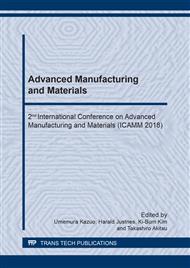[1]
J. F. Zhang, D. L. Mauzerall, T. Zhu, S. Liang, M. Ezzati, and J. V. Remais, Lancet, 2010, 375, 1110-1119.
DOI: 10.1016/s0140-6736(10)60062-1
Google Scholar
[2]
X.B. Hu, Z.G. Zhu, C. Chen, T.Y. Wen, X.L. Zhao and L.L. Xie, Sensor Actuat B-Chem, 2017, 253, 809-817.
Google Scholar
[3]
L. G. Teoh, Y. M. Hon, J. Shieh, W. H. Lai, and M. H. Hon, Sensor Actuat B-Chem,, 2003, 96(1), 219-225.
Google Scholar
[4]
V. Kruefu, A. Wisitsoraat, A. Tuantranont, and S. Phanichphant, Sensor Actuat B-Chem, 2015, 215, 630-636.
Google Scholar
[5]
I. Lee, S. J. Choi, K. M. Park, S. S. Lee, S. Choi, I. D. Kim, and C. O. Park, Sensor Actuat B-Chem, 2014, 197, 300-307.
Google Scholar
[6]
N. S. Ramgir, C. P. Goyal, P. K. Sharma, U. K. Goutam, S. Bhattacharya, N. Datta, M. Kaur, A. K. Debnath, D. K. Aswal, and S. K. Gupta, Sensor Actuat B-Chem, 2013, 188, 525-532.
DOI: 10.1016/j.snb.2013.07.052
Google Scholar
[7]
N. Datta, N. Ramgir, M. Kaur, M. Roy, R. Bhatt, S. Kailasaganapathi, A. K. Debnath, D. K. Aswal, and S. K. Gupta, Mater Chem Phys, 2012, 134(2-3), 851-857.
DOI: 10.1016/j.matchemphys.2012.03.080
Google Scholar
[8]
N. R, K. N. Madhusoodanan, and V. S. Prasad, Int. J. Environ. Sci. Toxicol, 2014, 2, 55-63.
Google Scholar
[9]
Y. H. Gui, F. H. Dong, Y. H. Zhang, Y. Zhang, and J. F. Tian, Mat Sci Semicon Proc, 2013, 16(6), 1531-1537.
Google Scholar
[10]
I. M. Szilagyi, S. Saukko, J. Mizsei, A. L. Toth, J. Madarasz, and G. Pokol, Solid State Sci, 2010, 12(11), 1857-1860.
Google Scholar
[11]
B. Zhang, J. D. Liu, S. K. Guan, Y. Z. Wan, Y. Z. Zhang, and R. F. Chen, J Alloy Compd, 2007, 439(1-2), 55-58.
Google Scholar
[12]
Y. B. Shen, B. Q. Zhang, X. M. Cao, D. Z. Wei, J. W. Ma, L. J. Jia, S. L. Gao, B. Y. Cui, and Y. C. Jin, Sensor Actuat B-Chem, 2014, 193, 273-279.
Google Scholar
[13]
W. T. Koo, S. J. Choi, N. H. Kim, J. S. Jang, and I. D. Kim, Sensor Actuat B-Chem, 2016, 223, 301-310.
Google Scholar
[14]
P. V. Tong, N. D. Hoa, V. V. Quang, N. V. Duy, and N. V. Hieu, Sensor Actuat B-Chem, 2013, 183, 372-380.
Google Scholar
[15]
X.B. Hu, Z.G. Zhu*, Z.H. Li, L.L. Xie, Y.H. Wu, Z.Y. Zheng, Sensor Actuat B-Chem, 2018, 264, 139-149.
Google Scholar
[16]
C. Wang, X. Li, C. H. Feng, Y. F. Sun, and G. Y. Lu, Sensor Actuat B-Chem, 2015, 210, 75-81.
Google Scholar
[17]
H. J. Xia, Y. Wang, F. H. Kong, S. R. Wang, B. L. Zhu, X. Z. Guo, J. Zhang, Y. M. Wang, and S. H. Wu, Sensor Actuat B-Chem, 2008, 134(1), 133-139.
Google Scholar
[18]
L. You, X. He, D. Wang, P. Sun, Y. F. Sun, X. S. Liang, Y. Du, and G. Y. Lu, Sensor Actuat B-Chem, 2012, 173, 426-432.
Google Scholar
[19]
C. Y. Lee, S. J. Kim, I. S. Hwang, and J. H. Lee, Sensor Actuat B-Chem, 2009, 142(1), 236-242.
Google Scholar
[20]
F. H. Saboor, T. Ueda, K. Kamada, T. Hyodo, Y. Mortazavi, A. A. Khodadadi, and Y. Shimizu, Sensor Actuat B-Chem, 2016, 223, 429-439.
Google Scholar


